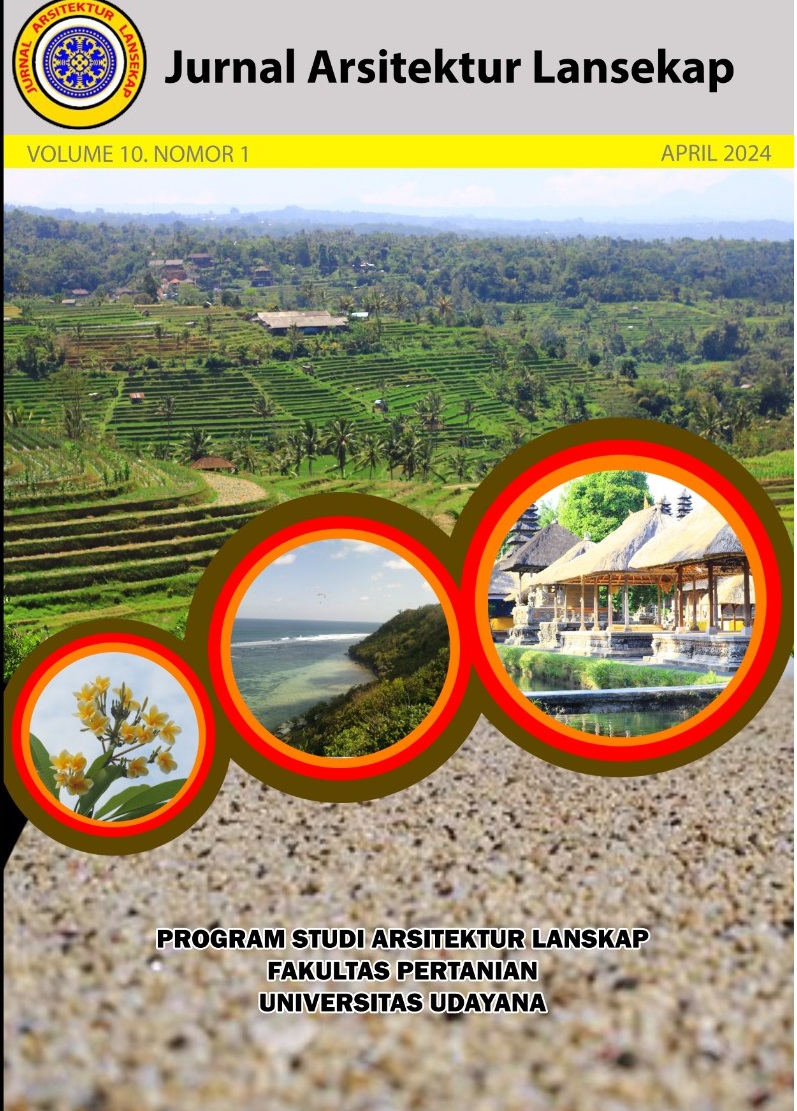Ketidaktaatan Terhadap Penggunaan Ruang Publik Ditinjau dari Theory of Planned Behavior (ToPB) di Kota Denpasar. Studi Kasus : Taman Kota Lumintang
Abstract
Public space is a place utilized by the community for recurring or regular activities. Misuse of public space that deviates from established norms and regulations leads to discomfort among users and conflicts between them. This disobedience is a phenomenon rooted in various factors. The Theory of Planned Behavior asserts that attitudes influence behavior. This means that the space influences individuals to perform specific planned behaviors. This research was conducted at Lumintang City Park, Denpasar, using a qualitative research method. Data collection techniques involved field observations, interviews, and documentation. Disobedient behaviors occurring in Lumintang City Park include smoking, defacing public facilities, skateboarding, driving in the park area, sleeping on benches, littering, vending in the park area, and bringing pets. The dominant factor influencing disobedient behavior, as per the Theory of Planned Behavior, is subjective norm.
Downloads
References
Ajzen, I. (2005). Attitudes, Personality and Behavior. In International Journal of Strategic Innovative Marketing (Vol. 3, hal. 117–191).
Antara. (2023). https://www.nusabali.com/berita/140455/forum-anak-kumpulkan-10000-puntung-rokok-dalam-satu-jam
BPS Kota Denpasar. (2021). Kota Denpasar Dalam Angka 2021. BPS Kota Denpasar
Carr, S., Francis, M., Rivlin, L. G., & Stone, A. M. (1992). Public space. Cambridge University Press.
Hasim, I. S., Saputra, A. S., Kusuma, F. T., Fitriani, Y., & Nugraha, P. O. (2016). Penyalahgunaan Fungsi Ruang Publik Sebagai Sarana Penunjang Aktivitas Penghuni Hunian Vertikal Kota. Reka Karsa: Jurnal Arsitektur, 4(2).
Katiandagho, M. Y. (2017). Analisis konflik pemanfaatan ruang pada jalur transportasi di kawasan Kota Manado. Jurnal Berkala Ilmiah Efisiensi, 17(02).
Prajnawrdhi, T. A. (2020). Kualitas Ruang Terbuka Hijau Kota Untuk Mewujudkan Denpasar Kota Sehat. In Seminar Nasional Komunitas dan Kota Berkelanjutan (Vol. 2, No. 1, pp. 21-28).
Porajouw, E. F. (2017). Efektivitas Ruang Terbuka Publik di Kota Tomohon. E-Jurnal Universitas Sam Ratulangi,4(1):136–148.
Rencana Aksi Kota Hijau (RAKH) 2016 Kota Denpasar. (2016). Kementrian Pekerjaan Umum dan Perumahan Rakyat. Direktorat Jendral Cipta Karya. Direktorat Bina Penataan Bangunan.
Permatasari, S. A., Mahagangga, I G. A. Oka. (2018). Studi Komparasi Taman Kota Lumintang Dan Taman Kota Puputan Margarana Niti Mandala Renon Sebagai Sarana Leisure and Recreation. Jurnal Destinasi Pariwisata. Vol.6 No 2, 2018.
Wang, S., Yung, E. H. K., Jayantha, W. M., & Chan, E. H. W. (2023). Elderly's intention and use behavior of urban parks: Planned behavior perspective. Habitat International, 134, 102780.
Whyte, W. H. (1980). The social life of small urban spaces.

This work is licensed under a Creative Commons Attribution-ShareAlike 4.0 International License.
An author who publishes in the Jurnal Arsitektur Lansekap (JAL) agrees to the following terms:
- Author retains the copyright and grants the journal the right of first publication of the work simultaneously licensed under the Creative Commons Attribution-ShareAlike 4.0 License that allows others to share the work with an acknowledgement of the work's authorship and initial publication in this journal
- Author is able to enter into separate, additional contractual arrangements for the non-exclusive distribution of the journal's published version of the work (e.g., post it to an institutional repository or publish it in a book) with the acknowledgement of its initial publication in this journal.
- Author is permitted and encouraged to post his/her work online (e.g., in institutional repositories or on their website) prior to and during the submission process, as it can lead to productive exchanges, as well as earlier and greater citation of the published work (See The Effect of Open Access).
Read more about the Creative Commons Attribution-ShareAlike 4.0 Licence here: https://creativecommons.org/licenses/by-sa/4.0/.







